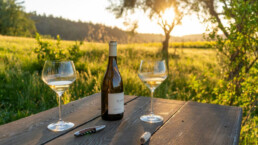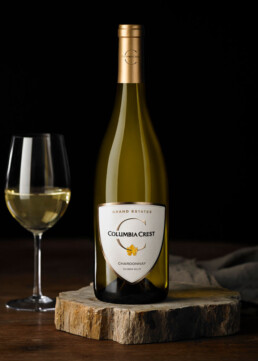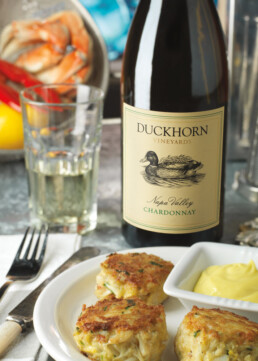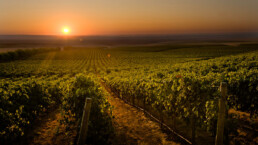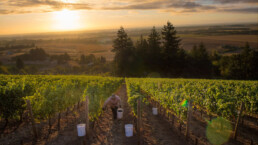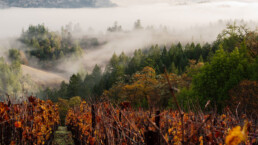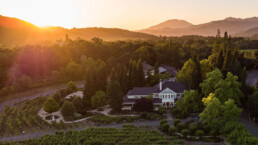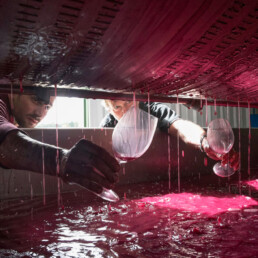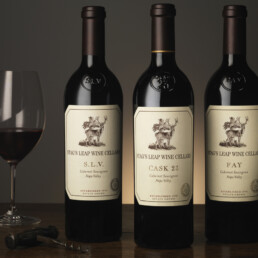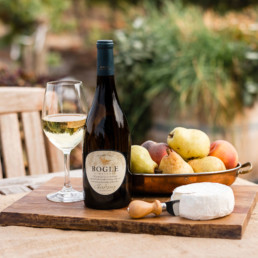Focus On: Chardonnay - The American Dream
It’s as American as Mom’s apple pie.
Chardonnay is the wine people seem to love to hate. And yet, Chardonnay is still the most popular grape variety in the United States, and the most widely planted white wine grape around the world. It seems, for as much as Chardonnay may have its haters, hey, we’re talking about you guys – the “ABC” (Anything But Chardonnay) club – this world-famous grape is definitely having a major moment!
Globally Chardonnay has achieved a level of branding unlike any other wine. Surprisingly, though, what you get when you buy Chardonnay can differ greatly from country to country and even within one country as is the case in the vastness of the US. So much depends on many factors – such as on the microclimate where it’s grown, the terroir, when it’s picked, how it is vinified and aged, and more!
The diversity is apparent where in the cool climate regions Chardonnay tends to be fresh, crisp and minerally with apple, stone fruit, and lemon notes compared to the warm climate characters of rich and buttery with tropical fruit overtones. Chardonnay definitely runs the gamut.
Luckily for us at Dhall & Nash, we are spoilt for riches when it comes to a variety of super sexy American Chardonnays. We have hung our hat on this from our early days of importing the luscious and ever-popular Coppola and Bogle wines. Now it is time to Focus On a few other ample beauties from our American collection.
Whether oaked or unoaked, Chardonnay is a white wine that is just as perfect on a beach in the summer as it is relaxing by the fire in the winter. Yet as much as we love or hate Chard, there’s still a lot that many of us don’t know about it which is really doing a disservice to this noble grape variety. Time now to see how American Chardonnays have come of age.
A 'Dolly Parton', An 'Audrey Hepburn' or an 'Angelina Jolie' – Take Your Pick!
Perhaps no other wine has such a flavour-forward reputation than American Chardonnay. It is often many wine drinkers’ first experience with a white American wine, and that experience was once typically punctuated by a mouthful of oaky flavour. Not gentle, dulcet tones of oak, but so much oak that one might find themselves inspecting their glass for wood splinters. Just jokin’! But it was true some of those early styles of white wines coming out of California were just too much oak for many of us.
Remember the context though – that was the bold and blaring ‘80s – big hair, big shoulder pads, big overblown oaky chardys drunk during big, long business lunches. Times have changed… Palates have evolved. What you liked a few years ago may be different than what you like today. Tastes change!
We have come to realise that that type of “butter bomb” Chardonnay is not always good with food either; too heavy, too cloying. However, with winemakers leading the charge and with consumers following, there has been a realisation that we wanted more acidity in the wines and more balance. But then defining balance (fruit, tannin, acidity, alcohol, structure, complexity) is somewhat akin to defining beauty – darn difficult and exceedingly elusive!
“Balance [in wine] exists, to some extent, in the eyes of the beholder.” – Rajat Parr (Acclaimed Sommelier & Co-Founder of In Pursuit Of Balance – wine movement)
To Oak or Not to Oak… Too Much of a Good Thing?
Firstly, Chardonnay is an aromatically neutral grape. Flavour-wise, Chardonnay is the ‘chicken’ (or ‘tofu’ for some folks) of the wine world. It is a blank canvas that winemakers are free to paint on. To oak, semi-oak or not to oak at all, to allow partial or full malolactic fermentation, or to add richness and texture by lees stirring – these are some of the factors a winemaker has to consider in choosing whether to create an angular ‘Angelina’ Chablis style of high acidity, no oak and minerality, or a voluptuous ‘Dolly Parton’ full-blown, buttery vanilla, richer style, or something understated and elegant in-between, an ‘Audrey’.
A disclaimer here though – quality is actually independent of style! Any Chardonnay, oaked or not, can be either awesome or poor. Yet it is the oaked style that tends to spark controversy mainly because some American winemakers haven’t always applied oak with a moderate hand.
“A kiss of oak is nice, but too much is the kiss of death.” – (Anonymous winemaker)
When oak is out of balance in Chardonnay, it sticks out in the form of toasty, sweet, caramelized aromas, and flavours, often with a strong hint of rich vanilla bean and coconut or even Bourbon! (if American oak barrels are used.)
There’s nothing wrong with those characteristics, of course, but all in moderation. How can a wine that sees a lot of new French or American oak maintain such balance? Experts believe it’s all about the vineyard and the intensity of the fruit it yields. Most vineyards simply don’t produce sturdy enough fruit to support a lot of new oak. Some more established vineyards have fruit with enough structure, natural acidity and hang time to support a certain level of oak. In other words, the more intense the fruit and the higher the acid levels, the more oak the wine can shoulder.
And guess what? “Buttery” Chardonnay has nothing to do with oak and everything to do with Malolactic Fermentation (MLF). That’s a process where Malic acid (think tart green apples) converts to Lactic acid (think rich creamy texture). If the winemaker allows this fermentation to occur – which happens after all the sugars have been converted to alcohol – you get a more “buttery”, creamy, and rounded texture. If they don’t, the wine is tarter and crisper. And of course, the winemakers can do varying percentages of MLF (called Partial MLF) dependent upon their fruit quality and style they wish to craft.
James Eyer, general manager at the renown Chardonnay specialist winery, Hyde de Villaine, said:
“As the wine culture of the USA and the world continues to grow, wine of elegance and distinction will become highly coveted … and consumers that believed they disliked chardonnay will be reintroduced to what I believe is the true expression of the varietal.”
Allow Us to Reintroduce You to American Chardonnay – Turning Down the Volume:
One aspect of the American wine scene we admire is its wonderful flexibility, and now, after a generation of big, oaky Chardonnay, there’s a quiet revolution going on as winemakers’, and consumers’, tastes evolve. All thanks to a gentle nudge from the now-defunct IPOB ‘In Pursuit of Balance’ movement started by internationally revered Sommelier Rajat Parr and winemaker Jasmine Hirsch. It was a catalyst for dialogue about minimal intervention, restraint, and elegance in wines.
Don’t get us wrong – we still looove those well-crafted rich Napa chardys, but at least for those of us who also like Chardonnay that emphasises elegance with a bit of grip and angularity, this is a timely rejuvenation.
No longer content with the turbo-charged chardys of the past, this American stylistic sea change is being driven by a generation of winemakers seeking to create wines that express every nuance of their terroir. These winemakers are ready to ‘turn the volume down’. They have started with the two most vital elements: clonal selection and site selection.
Without a doubt, both of these are of great importance when it comes to top-quality Chardonnay: lower-yielding clones, with small clusters grown in unique cooler climate areas. In California, the two most suitable clones were the heritage ones: Wente and Calera. For the conditions these have a high skin to juice ratio. For Oregon it was the French Dijon clones that worked their magic.
Guillaume Boudet, winemaker at the prestigious Hyde de Villaine winery, emphasized the importance of “selections naturally producing lower yields, small clusters and small berries, enhancing the true characteristics of the varietal and the site.”
In addition to pursuing vineyards closer to the coast and improving grape growing practices, vintners have undertaken a range of winemaking innovations. One of the key changes has been to move away from warmer extractions during fermentation to cooler and gentler techniques, allowing the characteristics of each vineyard site to shine more clearly in the wines. With this ever-increasing emphasis on viticultural and winemaking details, Chardonnays from cooler climate American sites have a role to play in continuing the region’s outstanding reputation and with inspiring a smidgeon of global influence too.
To help convert even the most ardent Chardonnay sceptics, we’ve pulled together a list of our Dhall & Nash faves from each of the West Coast regions.
Regionality - The West Coast Vibe:
American West Coast producers, from Columbia Valley in Washington State to the Willamette Valley in Oregon to Sonoma counties in California, are rethinking American Chardonnay. They may not be traditionally known for the grape when compared to the famous winemakers in Napa Valley who defined the now stereotypical buttery, oaky style for the white wine. But they are planting, producing, and experimenting with the wine – with a twist. They are skipping the big oak for a more restrained, Burgundian-inspired approach that values balance, freshness, and high acidity for a mineral-driven wine. This is more reflective of their terroirs. They aren’t trying to make a white Burgundy, but they are applying that French philosophy to the vineyard, winery, and cellar. The results are lighter-bodied wine that features tasting notes most wine drinkers wouldn’t necessarily associate with Chardonnay – oyster shell, Nashi pear, green citrus, flint, mineral – and it’s drawing in new consumers who claim to not drink the dreaded Chardonnay!
Washington State:
Even with all the rainfall on the western seaboard of Washington state, it produces stunningly good Chardonnays. How? The Cascade Mountains cause the primary difference. This massive mountain range runs north-south through the state blocking the cool air and precipitation that head east from the Pacific. Here in the ever-warm Columbia Valley, is where the vast majority of the state’s wine grapes are grown. This region provides lush, ripe fruit flavours, while cool nights preserve natural acidity. This yields wines often fuller in style than their peers from Burgundy, but lighter and graced with more acidity than many offerings from California. As always with Washington, the wines can also provide incredible value!
Columbia Crest:
A Washington winery in the Horse Heaven Hills AVA within the Columbia Valley. Founded in 1983, Columbia Crest has grown from a small winery in a relatively unknown wine region to one of the most significant wineries in the U.S. and a major force behind Washington state’s emergence as a world-class wine region. Over the years, the winery has remained committed to the delivery of handcrafted, small-lot wines, as well as affordable, superior quality everyday wines.
2019 Columbia Crest Grand Estates Chardonnay – “Sensationally Slurpable”
Opens with intense aromas of apples and melons, joined by signature characters of crème brulee, caramelized sugar and butterscotch. Ripe orchard fruit flavours are joined by creamy, buttery notes and balanced by lively acidity.
Oak regime: 78% fermented in French and American oak barrels. Matures for 9 months on the fine yeast. The remaining 22% is fermented and expanded in stainless steel tanks.
“Silky and seductive, with pear and spicy grapefruit flavours on a taut, polished frame, lingering with intensity and brightness on the glowing finish. Impressive for the price. Drink now.” 90/100 points, Wine Spectator
Oregon:
Sandwiched between California and Washington, Oregon’s classy efforts could be overlooked. Yet, as a much-lauded producer of world-class Pinot Noir, why couldn’t Burgundy’s iconic white wine grape also thrive in Oregon? In fact, it does.
Initially however, Chardonnay in Oregon got off to a less-than-impressive start. California-sourced Wente clones were widely planted, producing a thick, dull, early-ripening style of wine. But the state’s Chardonnays took a great leap forward in the 1990s, as a few winemaking pioneers began replacing Wente clones with Burgundian Dijon clones.
The similar Burgundian climate of the Willamette Valley has proven to be particularly suited to these new clones, and the resulting Chardonnays have a stunning energy. It is this intensity with subtlety of Oregon’s best Chardonnay versions that differentiate them from the crowded West Coast competition.
In Oregon, the grape’s inherent transparency and elegance punches up the aromatics, bringing nuances of soil and site, herb, and earth, along with crisp citrus fruit. Some winemakers try to enhance these qualities with all-stainless, concrete egg and clay amphorae-fermented wines, which prove that barrel ageing is only an option, not a requirement, for complexity.
Cristom Vineyards:
2018 marked the inaugural release of Cristom Vineyards’ Eola-Amity Hills Chardonnay, featuring fruit from their own estate Louise and Paul Gerrie vineyards, as well as five other neighbouring sites in the Eola-Amity Hills AVA. Though they are no strangers to Chardonnay, having produced the varietal since their founding in 1992, this new release marks the expansion of Cristom’s Chardonnay programme, both through collaborating with extraordinary neighbouring winegrowers, as well as the expansion of Chardonnay plantings on the Cristom Estate.
2018 Cristom Eola-Amity Hills Chardonnay – “Purity & Precision”
Rated “One of the Year’s Best Chardonnays of 2020” by Wine & Spirits Magazine.
Oak regimen: Aged in 31% New French oak barriques for 12 months. 13% alc.
“Restrained and delicate, this cool Chardonnay leads with dry lemon-lime scents. With its tart green-apple flavour, lemon-rind lift and talc-like mineral tang, it’s a Chablis-like Chardonnay for oysters.” 91/100 points, Wine & Spirits
“The 2018 Chardonnay Eola-Amity Hills, aged 12 months in 31% new French oak, offers fresh orchard fruits with touches of almonds, white flowers, and baker’s yeast. The palate is light-bodied but surprising with its depth of fruit, with soft freshness and a long, delicate finish.” 91/100 points, Robert Parker’s Wine Advocate
California:
This is the state that invented Big, Bold, and Beautiful! More than 80% of the wine made in the USA is made in California, making it the fourth largest producer of wine in the world (behind Italy, France and Spain). California wine regions run the length of the state and have 139 American Viticultural Areas or AVAs. Each American Viticulture Area has a distinct “persona” that divides it from the other AVAs. The distinct “persona” is mainly categorized by climate, geology, and elevation. No surprise, Napa Valley was the original California AVA.
“California Chardonnay has swung from lush to skinny and back again in the past two decades, and finally the pendulum has come to rest.” – Elaine Chukan Brown
It has definitely been on a rollercoaster ride of changing styles and tastes. But more recently, winemakers have begun to find a happy middle ground, balancing mouth-watering flavour with respect for what the vineyard gives them.
Sonoma Coast AVA:
Sometimes called “Burgundy on the Pacific”. The two famed grapes of France’s esteemed Burgundy area – Pinot Noir and Chardonnay – have both found a new home in this part of California.
Flowers Vineyards & Winery:
The pioneers of the Sonoma Coast. When others said it couldn’t be done, in 1989, Joan and Walt Flowers were among the first to plant grapes on the first ridgeline off the Sonoma Coast. The extreme Sonoma Coast is a place of unique character with the Pacific Ocean less than two miles from the vineyards, generating cooling sea breezes and coastal fog, while the soaring elevations range from 1,150 to 1,450 feet positioning the vineyard above the coastal fog layer, thus allowing generous amounts of sunshine during the growing season. This unique combination of abundant sunshine and cooling fog rolling in and out of the vineyard creates an idyllic growing environment for elegant and nuanced Chardonnay showing bright fruit focus, complex minerality and crystalline acidity.
2018 Flowers Sonoma Coast Chardonnay – “Masterful Elegance”
100% native yeast.
Oak regimen: Aged for 3 months on lees in stainless steel tanks. 100% French Oak (18% new) for 11 months.
“This classy 2018 has notes of musky pineapple, crushed citrus, and white flowers as well as a kiss of salty minerality. It has bright acidity, beautiful balance, and is just a classic, elegant Sonoma Coast Chardonnay that does everything right.” 93/100 points, Jeb Dunnuck
Russian River Valley AVA:
Also within Sonoma County, this is a highly regarded growing region for Chardonnay. Characterized by its cool climate and coastal fog that travels in from the Pacific along the Russian River, the Russian River Valley’s climate allows for a slow ripening of the grapes, resulting in wines of balanced acidity and complexity.
Kosta Browne:
Once again, we see the marine influence that follows the Russian River inland from the Pacific coast is a powerful attribute of this region. This is from the coolest parts of the Russian River Valley. Here, fruit is allowed to mature gracefully on the vine, which offers more intensely focused flavours and generous natural acidity.
Kosta Browne was informally founded by Dan Kosta and Michael Browne when the two pooled their tip money from restaurant work and bought some Pinot Noir grapes in 1997. The company has now become a bit of a cult winery commanding premium prices for their primo wines
This vintage Kosta Brown winemaker Julien Howsepian continued his pursuit in delivering exceedingly fresh and precise wines by incorporating traditional, and non-traditional French oak foudres into their Chardonnay winemaking. These larger vessels seamlessly weave complexity and purity into one, integrating the gross lees and the wine with slower and patient micro-oxygenation due to thicker oak staves and less wood to wine contact ratio.
Winemaker Howsepian describes the Chardonnays as “energetic in spirit but rich in body”.
2017 Kosta Brown ‘One Sixteen’ Russian River Valley Chardonnay – “Statuesque & Stylish”
Oak & ageing regimen: 34% New French Oak for 15 months / 30% Stainless Steel tank for 4 months / 18% Foudre for 9 months / 1% Concrete tank for 15 months / 2% Concrete egg for 14 months.
“A beautiful Chardonnay … brought up in 34% new French oak, the 2017 Chardonnay One Sixteen Russian River Valley sports a medium gold colour as well as a rich, powerful bouquet of caramelized citrus, white currants, toasted hazelnuts, and brioche. Deep, rich, medium to full-bodied, and beautifully textured, it has flawless balance, bright acidity, and is a profound Chardonnay that will stand beside the finest white Burgundies.” 97/100 points, Jeb Dunnuck
Napa Valley:
No other wine region on the planet draws as much attention as Napa Valley. Its incomparable beauty couples seamlessly with generations of passionate winemakers behind some of the world’s truly exquisite wines. Here the combination of Mediterranean climate, geography and geology of the region are conducive to growing top-quality wine grapes. It is Napa’s great diversity, both in terms of climate and terroir, that has led to the creation of 16 smaller AVAs like Stags Leap District, Rutherford, Howell Mountain, Oakville, and Mount Veeder, among others. Here Cabernet and Chardonnay still reign supreme.
Stag’s Leap Wine Cellars:
Stag’s Leap Wine Cellars, notably known for being the winery that won the Cabernet Sauvignon competition in the famous 1976 Judgment of Paris, was founded in 1970, and is considered a Napa Valley first-growth estate. They create wines of classic beauty – wines with balance, complexity, and harmony. Their signature style has often been described as “an iron fist in a velvet glove”, a reference to the artful balance between ripeness and restraint, softness, and structure, that yields Napa Valley wines of exceptional beauty and long life.
With a tradition of mentoring that dates back to our founding in 1970, Stag’s Leap Wine Cellars has been a springboard for many a celebrated winemaker’s career. This Chardonnay is a tribute to the alumni whose vision of crafting elegant and balanced wines has been passed down from teacher to student, and “through the hands of time”.
2018 Stag’s Leap Hands of Time Chardonnay – “Generous & Vivacious”
Ageing regimen: 6 months on lees, stirred every 2 weeks, 91% previously filled French oak barrels (9% new).
“This is an opulent, structured and mineral-driven white wine, richly layered and robustly built with weight and ample body. Brioche, honeycomb, and baked apple meet a complement of fresh acidity and a lasting note of stone.” 91/100 points, Wine Enthusiast
Duckhorn Vineyards:
Duckhorn has been making wine using grapes from the finest Napa Valley vineyards for over 40 years. Building on this rich history, their Napa Valley Chardonnay comes from the coolest regions. In the cellar, they have applied classic techniques of French oak barrel fermentation with lees stirring, resulting in a Chardonnay that balances the complexity and richness of Napa Valley.
2018 Duckhorn Vineyards Napa Valley Chardonnay – “Opulent & Unapologetic”
40% malolactic fermentation.
Oak & ageing regimen: 10 months in French oak; 40% new oak, 30% 2nd vintage, 30% neutral.
“A full-bodied, creamy white, showing lots of ripe fruit on the nose with peach pie, baked apple, and mango, followed by hazelnut and custard pastry on the palate. Crisp acidity.” 93/100 points, James Suckling
“With grapes from such stellar sites as Hudson, Trefethen, Antinori and Stanley Ranch, this white is lush, seamless, and sound across the board. It is approachable and fleshy in apple, pear, and mango tones, accented by toasted oak and vanilla.” 90/100 points, Wine Enthusiast
Unlike the spiritual homeland of Chardonnay, Burgundy, the beauty of American Chardonnay is that there are no rules. Well, there are very few regulations let’s say, a wide range of terroirs and the local vintners are willing to explore all the stylistic possibilities appropriate to their land while keeping a close eye on the market.
As we know, in the end, it’s all a matter of taste. Consumers will decide for themselves the style of Chardonnay they like, unoaked, heavily oaked, or something heavenly in between. So, raise a glass to the resilience, creativity, and passion of America’s winemakers and enjoy this bounty of luxuriously luscious Chardonnays!
